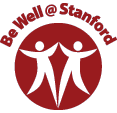A culture of connections
 With over 25 schools and units at Stanford, approximately 600 buildings, and an employee population of over 14,000 faculty and staff, it can be a challenge to build connections with others outside your immediate work group or department. Many even struggle to get connected with those they see each and every day. We spend about 30 percent of our time at work, so it’s important to understand the effects that positive (or negative) connections can have in our working lives. To better understand the issues, BeWell spoke with Brittany Cripe, senior communications specialist with Stanford University Human Resources.
With over 25 schools and units at Stanford, approximately 600 buildings, and an employee population of over 14,000 faculty and staff, it can be a challenge to build connections with others outside your immediate work group or department. Many even struggle to get connected with those they see each and every day. We spend about 30 percent of our time at work, so it’s important to understand the effects that positive (or negative) connections can have in our working lives. To better understand the issues, BeWell spoke with Brittany Cripe, senior communications specialist with Stanford University Human Resources.
Tell us why we should be concerned about how well-connected we are?
Consider these facts:
- Having positive connections in the workplace reduces stress hormones; increases the neurotransmitters responsible for attention, feelings of pleasure and trust; and keeps fear and worry at bay.
- Those who are happy at work are more engaged and are therefore more productive.
- Those who work in a collaborative and connected environment are more willing to contribute new and bold ideas that lead to better results.
- Mortality rates are significantly lower among employees who report peer social support in the workplace.
In a recent article on workplace stress, Jeffrey Pfeffer (Thomas D. Dee II Professor in the Graduate School of Business) shared that “hosting social events and building a strong workplace culture that permits people to share their personal lives with one another is one way to improve social connections.” He goes on to say, “Allowing employees the opportunity to find social support on the job is another great way to reduce workplace stress.”
What are the best ways to build connections in a Stanford work group and the broader community?
Within the office, there are many things you can do to forge positive connections with your colleagues. Some actions to consider:
- Recognize that everyone has varying needs for connection
- Identify shared interests
- Be present and fully attentive
- Emphasize positives
- Express your thanks
- Provide feedback using constructive language
- Practice “Hi” and “Goodbye”
- Practice empathy
- Connect over lunch or department social events
- Proactively help others
- Expect the best in people
- Negotiate to solve problems, not to win
Are there specific programs that can help enhance work group connectivity?
Special-interest/activity groups
Many schools and units have formed various groups within their departments — such as knitting groups, book clubs and more. To find out about groups like these in your department, talk to your HR Manager.
Health Work Environment (HWE) groups
One of the most ground-breaking programs is the Healthy Work Environment (HWE) initiative. Only in its second year at Stanford, the Healthy Work Environment program, a part of the BeWell EIP program, enhances workplace connectivity while also directly impacting the health and wellness of each and every work group member. The HWE program is designed to support the enhancement of worksite well-being. A HWE group, formed by a work group Ambassador, participates in wellness activities onsite, where sustaining healthy behaviors can be made easier in a supportive work environment and accountability to the group can enhance individual behavior change.
By participating in group goals for one quarter (10-week engagement), HWE group members (including Ambassadors) can each earn $100 per program year. Ambassadors also receive material support as needed, periodic gifts, and recognition at the annual BeWell Recognition Event in December.
Employees may join a pre-existing HWE group on their BeWell account, or become an Ambassador and start their own group. To view active HWE groups, please login, then click on “Find a Group Near You” under the Healthy Work Environment tab.
I want to benefit from better connections within my work group, but I’d also like to broaden my connectivity to other people on campus. How can I do that?
Cardinal at Work
Cardinal at Work facilitates events, activities and new and improved ways to connect — both virtually and in person — so that employees can feel more engaged at Stanford. The Connect subsite in the Cardinal at Work website has details about employee and university events, staff affinity groups, email lists and newsletters, volunteer opportunities, workplace recognition events, social media channels and more. And, by participating in the monthly #CardinalConnect polls, contests and activities, you can come away with a greater sense of belonging, and a prize if you’re a lucky winner!
We encourage you to check out Cardinal at Work | Connect and set a goal to try one new action to get connected at Stanford this month. Whether it’s attending a university event, participating in one of the #CardinalConnect contests, or having lunch with a colleague, these simple practices can really add up when it comes to your overall sense of well-being and happiness at work.
The Voice & Influence Circles™ Program is designed to positively impact Stanford staff through peer mentoring, networking and community building.
Classes and workshops
While not groups designed for connecting, per se, attending classes and workshops held at Stanford can be a great way to make a few new connections and share common interests — beyond your work group. Check out the multitude of offerings at:
Cardinal at Work:
Learn & Grow | Courses and Connections, Stanford Sweeteners
Work-Life: Feed Your Brain Workshops, Programs and Seminars
Health Improvement Program (HIP) classes
Stanford Recreation (REC) classes and Group Fitness Program
Are there specific events this spring that promise to enhance connectivity at Stanford?
Too many to count, but check out these events (and links):
12th Annual Wellness Fair - Wednesday, March 16 at ACSR
Frost Music & Arts Festival – headliners announced March 14/15
Sustainable Stanford Earth Day Celebration – Tuesday, April 10, at Ford Plaza
Healthy Taste of Stanford - Wednesday, April 27
Stanford Lu’au - date TBA
Stanford PowWow – May 6-8 (To volunteer, email: supowwow.volunteer@gmail.com)
Cardinal Walk – Friday, May 13, ACSR (Erickson Courts)
Multicultural Springfest/Celebrating Staff Careers – Date TBA
View more activities, volunteer opportunities and groups
Answer and Win!
For a chance to win a lunch for you and a colleague, answer three short questions about staying connected at Stanford.
Answer questions and enter to win
Sources:
Carlson, 1998; Rosenthal and Jacobson, 1992; Resnick, 1997; Cohen, 1997; Berkman,
1979; Baumeister, 2003; MacArthur Foundation Study, 1998.
LaPlante, A. (2011, April 1). If money doesn’t make you happy, consider time. Retrieved from
https://www.gsb.stanford.edu/insights/if-money-doesnt-make-you-happy-consider-time.
Crow, T. (2014, January 2). Workplace leadership: Emotional connection leads to higher
employee productivity. Retrieved from http://hr.blr.com/HR-news/Staffing-Training/Leadership/
/Workplace-leadership-Emotional-connection-leads-to/#.
Dutton, J. (2003, Winter). Fostering high-quality connections. Retrieved from
http://ssir.org/articles/entry/fostering_high_quality_connections.
Shirom, A., Toker, S., Alkaly, Y., Jacobson, O., & Balicer, R. (2011). Work-based predictors of
mortality: A 20-year follow-up of healthy employees. Health Psychology,30(3), 268-275.
Stallard, M. L. (2015). Connection culture.Alexandria, VA: ATD Press.
